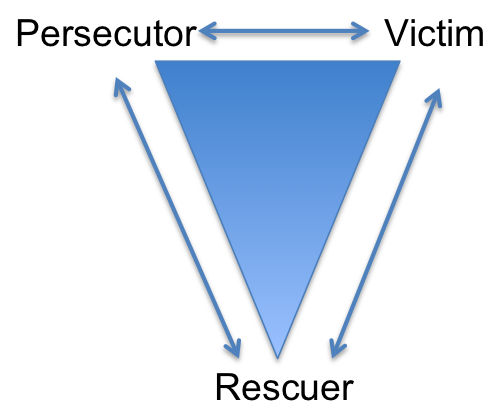The Rescuer
“It’s faster to do it myself than to delegate it to others…” or “If I want it done right, I’m the one who has to do it…” or “Let me do this for you…”
These are the words of the Rescuer – the person, or in this case the leader, who solves problems for others that they should solve for themselves.
The Victim
“No matter how hard I try, they keep giving me this stuff…” or “Poor me…” or “I’ve been put in an awkward situation…”
Meet the Victim. This is the person who comes to the leader with an issue. They have a “problem orientation.” In other words, they show up without suggestions, solutions, or alternatives because they know their leader will solve the problem for them. They place blame on the Persecutor (see below) and seek a Rescuer for the “fix.”. The Victim often believes he is powerless over his environment and that things often happen “to” him. One problem replaces another, creating a roller coaster of tension and relief as they seek rescue.
The Persecutor
“It’s all your fault…” or “We can’t do this…” or “Management pushes things on me…”
This is the Persecutor – the person or situation that agitates the Victim. They place blame, criticize, and often set strict limits unnecessarily.
The Drama
When leaders play the role of the Rescuer, they perpetuate a cycle known as the Drama Triangle, a dysfunctional model of human interaction first described by Stephen Karpman. The Rescuer often doesn’t have the self-awareness to know they are rescuing others because they gain a sense of self-worth as the “hero” and enjoy having others dependent on them. In essence they are satisfying their own selfish needs rather than acting for the good of the organization. On the surface it appears they are helping, but at a deeper level they “play” upon the Victim in order to continue getting their payoff.
All three roles need each other to survive, and if you play one role in an organization, you are likely to shift to the other roles as well.
Here are some symptoms you might see if your team is caught in the triangle:
- Team members complain (a lot), make excuses, and bring problems (without solutions) to their manager.
- People finger-point and place blame on others or situations “outside of their control.”
- Everything is black and white.
- Denial, defensiveness, and a lack of accountability are the norm.
- Isolation and cynicism preside.
These symptoms lead to broader consequences to the organization including:
- Over emphasis on tactical day-to-day activities where leaders don’t have time for strategic thinking and long-term planning because they are constantly focused on rescuing others. As a result they…
- Lead at a lower levels, micro manage others, and spend too much time on details that don’t make a bit of difference. As a result…
- People focus on the task and its accurate completion instead of what the business needs at the moment. As a result…
- Decisions are slow to be made. As a result…
- Creativity wanes and innovation becomes non-existent.
Not a fun place to work, is it?
Is your team caught in the triangle? Is your leadership style perpetuating the cycle? Do you want to end the victimhood and drama?
From Rescuer to Enabler
The solution starts with the Leader when he shifts from a rescue mindset to that of a coach or enabler. Instead of thriving on dependency, the coach/enabler thrives on helping others succeed. They work to enable others to grow instead of working to grow their own ego. They know longer “fix” problems for others, rather they…
- Listen carefully and actively.
- Ask leading questions so that others can see possibilities.
- Provide feedback so that team members know what they need to do differently to succeed.
- Empower others to make decisions and act.
- Allow their team members to fail forward – to make mistakes and then learn from them.
- Follow-up, ensuring their approach isn’t overly hands-off or overly hands-on.
- Shift the environment to a goal orientation – where the vision is clear and values guide the way.
- Create a culture of trust where people are comfortable engaging in critical debate and holding each other accountable.
From Victim to Victor
When the leader begins asking questions instead of “fixing” the situation, the culture begins to shift from a “problem orientation” to an outcome orientation. In an outcome orientation, the Victim doesn’t exist and instead becomes the Victor. They bring ideas, solutions, and alternatives to the leader and see challenges as an opportunity to become better or to think differently. They take responsibility for their own actions and take ownership for their own success. They recognize when they slip back into the role of Victim and are comfortable admitting their mistakes. They communicate their needs assertively and recognize that their needs are just as important as those of others.
From Persecutor to Innovator
When the Persecutor shifts to an Innovator, the blame game disappears and critique moves from a focus on agitating others to finding a better solution for the business. The Innovator challenges ideas instead of making insulting, evaluative and judgment-based statements that shut-down conversation. They create dialogue and debate that stimulates creative thinking. When they hold others accountable, they do it for the good of the organization and business and not as the attacker.
The Result
The cycle of victimhood ends. Drama decreases. Politics and turf wars are minimized. The leadership pipeline strengthens. Innovation returns to the workplace. Individual leaders no longer feel the need to constantly rescue others to feel good about themselves and are freed-up to focus on more important issues, strategy, and long-term planning.

